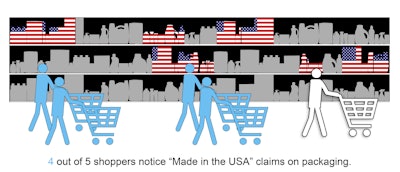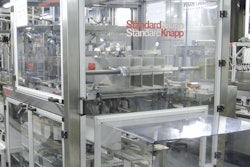
In the latest shopper research survey conducted by Perception Research Services International, results indicate that four out of five shoppers notice “Made in the U.S.A.” claims on packaging—similar to 2011 levels (83% vs. 80%). And 76% of those shoppers claim that they are more likely to purchase a product after noticing the “Made in the U.S.A” claim.
These shoppers maintain that the number one reason they are more likely to buy “Made in the U.S.A.” is to “help the economy.” Yet, the products they say they would prefer to purchase—if American-made—suggest that quality and safety may be the true motivating factors. These include food, medicine, and personal care items.
For the first time this year, the survey asked shoppers in the U.S. about products that tout a “Made in China” claim. This is noticed nearly as much as “Made in the U.S.A.” (76% vs 83%). However, 57% say they are less likely to purchase products that are Made in China—mostly because of safety and quality concerns. The positive associations with “Made in China” are related to a better price.
Shoppers ages 35 and over are the most likely to be positively influenced by the “Made in the U.S.A.” claim and the most negatively influenced by the “Made in China” label. It’s not clear if the 18 to 34-year-olds see the world differently based on their collective experiences and influences, or if they simply have not yet reached an age where they’re affected by these considerations.
Interestingly, preliminary data from China that reveals that a “Made in China” claim does not resonate as well there as “Made in the U.S.A.” does here. Just 58% of shoppers in China that notice a “Made in China” claim are positively influenced by it. The primary reason given is a better price.
"Whether it is for quality assurance, to boost the economy, or out of patriotism, buying American-made products is becoming quite fashionable among U.S. shoppers,” says Jonathan Asher, executive vice president of PRS. "Particularly for products that are ingested such as food, beverages, and medicines—if you make it here, make that clear—that is, include a “Made in the U.S.A.” mention on your package (and possibly other marketing communications) so that shoppers are aware of that fact.”
This research for “Made in the U.S.A.” was conducted in July 2012 among more than 1,400 consumers, aged 18 and over, drawn from a nationally representative online sample in the U.S. The “Made in China” study was conducted in August/September 2012 among approximately 500 consumers, aged 18 and over, drawn from a nationally representative sample in China.

























